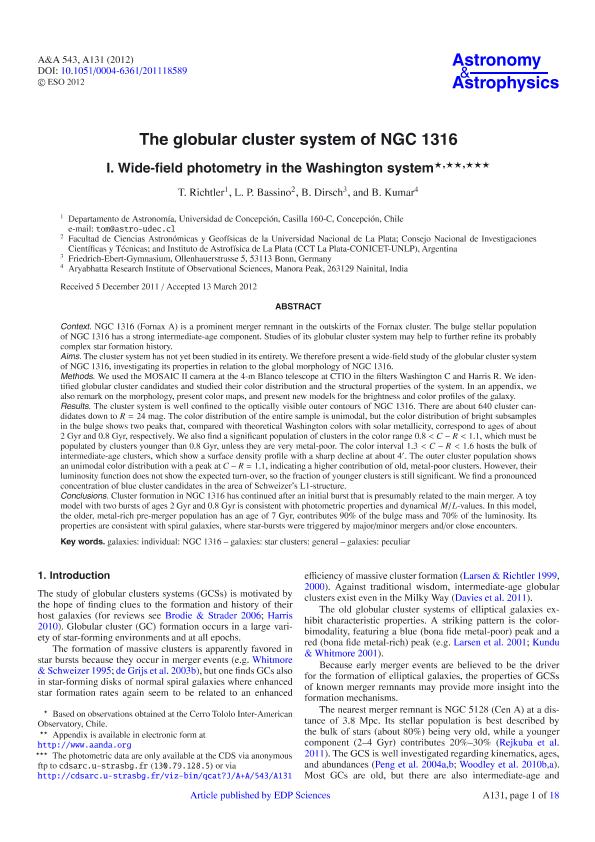Artículo
The globular cluster system of NGC 1316: Wide-field photometry in the Washington system
Fecha de publicación:
07/2012
Editorial:
Edp Sciences
Revista:
Astronomy And Astrophysics
ISSN:
0004-6361
e-ISSN:
1432-0746
Idioma:
Inglés
Tipo de recurso:
Artículo publicado
Clasificación temática:
Resumen
Context: NGC 1316 (Fornax A) is a prominent merger remnant in the outskirts of the Fornax cluster. The bulge stellar population of NGC 1316 has a strong intermediate-age component. Studies of its globular cluster system may help to further refine its probably complex star formation history.
Aims: The cluster system has not yet been studied in its entirety. We therefore present a wide-field study of the globular cluster system of NGC 1316, investigating its properties in relation to the global morphology of NGC 1316.
Methods: We used the MOSAIC II camera at the 4-m Blanco telescope at CTIO in the filters Washington C and Harris R. We identified globular cluster candidates and studied their color distribution and the structural properties of the system. In an appendix, we also remark on the morphology, present color maps, and present new models for the brightness and color profiles of the galaxy.
Results: The cluster system is well confined to the optically visible outer contours of NGC 1316. There are about 640 cluster candidates down to R = 24 mag. The color distribution of the entire sample is unimodal, but the color distribution of bright subsamples in the bulge shows two peaks that, compared with theoretical Washington colors with solar metallicity, correspond to ages of about 2 Gyr and 0.8 Gyr, respectively. We also find a significant population of clusters in the color range 0.8 < C − R < 1.1, which must be populated by clusters younger than 0.8 Gyr, unless they are very metal-poor. The color interval 1.3 < C − R < 1.6 hosts the bulk of intermediate-age clusters, which show a surface density profile with a sharp decline at about 4 . The outer cluster population shows an unimodal color distribution with a peak at C − R = 1.1, indicating a higher contribution of old, metal-poor clusters. However, their luminosity function does not show the expected turn-over, so the fraction of younger clusters is still significant. We find a pronounced concentration of blue cluster candidates in the area of Schweizer’s L1-structure.
Conclusions:. Cluster formation in NGC 1316 has continued after an initial burst that is presumably related to the main merger. A toy model with two bursts of ages 2 Gyr and 0.8 Gyr is consistent with photometric properties and dynamical M/L-values. In this model, the older, metal-rich pre-merger population has an age of 7 Gyr, contributes 90% of the bulge mass and 70% of the luminosity. Its properties are consistent with spiral galaxies, where star-bursts were triggered by major/minor mergers and/or close encounters.
Palabras clave:
Galaxies
,
Ngc1316
,
Star Clusters
Archivos asociados
Licencia
Identificadores
Colecciones
Articulos(IALP)
Articulos de INST.DE ASTROFISICA LA PLATA
Articulos de INST.DE ASTROFISICA LA PLATA
Citación
Richtler, T.; Bassino, Lilia Patricia; Dirsch, B.; Kumar, B.; The globular cluster system of NGC 1316: Wide-field photometry in the Washington system; Edp Sciences; Astronomy And Astrophysics; 543; 7-2012; 1-18
Compartir
Altmétricas




